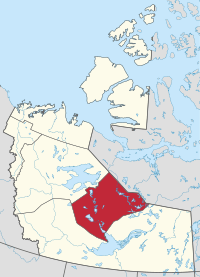Tlicho Government
The Tlicho Government, Tłı̨chǫ Government, Tli Cho, is a First Nations organization representing the Tłı̨chǫ Nation, Dene people of the Northwest Territories, Canada that was created in 2005 when the Tłı̨chǫ Nation ratified the Tłı̨chǫ Agreement[2] with the Government of Canada.
Tłı̨chǫ Government Tłı̨chǫ Ndek'àowo (Tłı̨chǫ) | |
|---|---|
Indigenous government | |
 Flag | |
| Motto(s): Strong like two people | |
 Wekʼèezhìı within the Northwest Territories | |
| Country | Canada |
| Territory | Northwest Territories |
| Region | North Slave |
| Territorial riding | Monfwi |
| Established | August 4, 2005 |
| Government | |
| • Grand Chief | David Wedawín |
| • Communities | Behchokǫ̀ Gamèti Wekweètì Whatì |
| Population (2016) | |
| • Total | 2,751 |
| Website | Official website |
Through this agreement certain rights relating to lands, resources and self-government were defined including Tłı̨chǫ Government ownership of "39,000 km2 of land located between Great Slave Lake and Great Bear Lake including surface and subsurface rights, the ability to define its membership known as Tłı̨chǫ citizens, jurisdiction over lands and resources in the Tłı̨chǫ traditional territory and establishment of the Wekʼèezhìı Land and Water Board and the Wekʼèezhìı Renewable Resources Board and a share of mineral royalties from the Mackenzie Valley."[3] The word Tlı̨chǫ [tɬʰĩtʃʰõ] means Dogrib.[2]
The traditional area of the Tłı̨chǫ described by Chief Monfwi during the signing of Treaty 11 in 1921, was called Monfwı̀ Gogha Dè Nı̨htł'è [mõfwì goɣa dè nĩhtɬ'è].[2] Wekʼèezhìi, the management area defined by the Tłı̨chǫ Agreement,[2] is an area larger than the land owned by the Tłı̨chǫ. Wekʼèezhìi "shares boundaries with the Sahtu Settlement Area and Nunavut, and includes the four Tłı̨chǫ member communities of Gamètì, Wekweètì, Whatì and Behchokǫ̀."[4] The area includes the Ekati and Diavik Diamond Mines.
NWT Conference of Management Authorities (CMA)
The Tłı̨chǫ Government is one of the Management Authorities of the NWT Conference of Management Authorities (CMA) for boreal caribou, along with the Government of the NWT, the Wildlife Management Advisory Council (NWT), the Gwich'in Renewable Resources Board, the Sahtu Renewable Resources Board, and the Wekʼèezhìi Renewable Resources Board.[5]
Wekʼèezhìi Renewable Resource Board
The Tłı̨chǫ Government appoints fifty percent of the Wekʼèezhìi Renewable Resource Board, a co-management board. The other fifty percent are appointed by the Government of Canada and the Government of Northwest Territory. The WRRB is an institution of public government, responsible for managing wildlife and wildlife habitat (forests, plants and protected areas) in the Wekʼèezhìi area.[6]
Woodland caribou (Rangifer tarandus caribou)
Based on the 2012 Species at Risk Committee's (SARC) report, the NWT Conference of Management Authorities (CMA) in October 2013 added boreal woodland caribou to the Northwest Territories List of Species at Risk as a threatened species.[5]
Footnotes
- Government of the Northwest Territories. "NWT Indigenous Governments". Retrieved 2019-06-09.
- Government of Canada 2003.
- WRRB nd.
- Wek'èezhìi Renewable Resources Board (WRRB) nd.
- Conference of Management Authorities (CMA) 2013.
- Wekʼèezhìi Renewable Resources Board (WRRB) nd.
References
- Consensus agreement on listing boreal caribou (Rangifer tarandus caribou) (PDF), Species at Risk, Northwest Territories, 9 October 2013, archived from the original (PDF) on 29 October 2014, retrieved 21 October 2013
- "Tlicho Agreement", Government of Canada, August 2003, retrieved 21 October 2014
- "The Wekʼèezhìi Renewable Resources Board (WRRB)", Wekʼèezhìi Renewable Resources Board (WRRB), nd
- "Tłįcho Agreement", WRRB, 2005, retrieved 21 October 2014